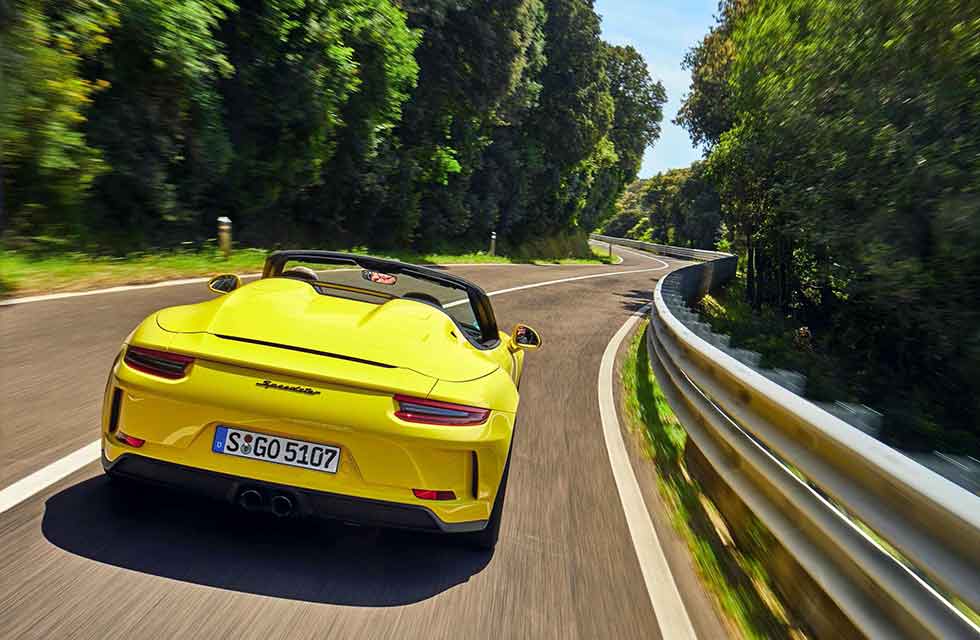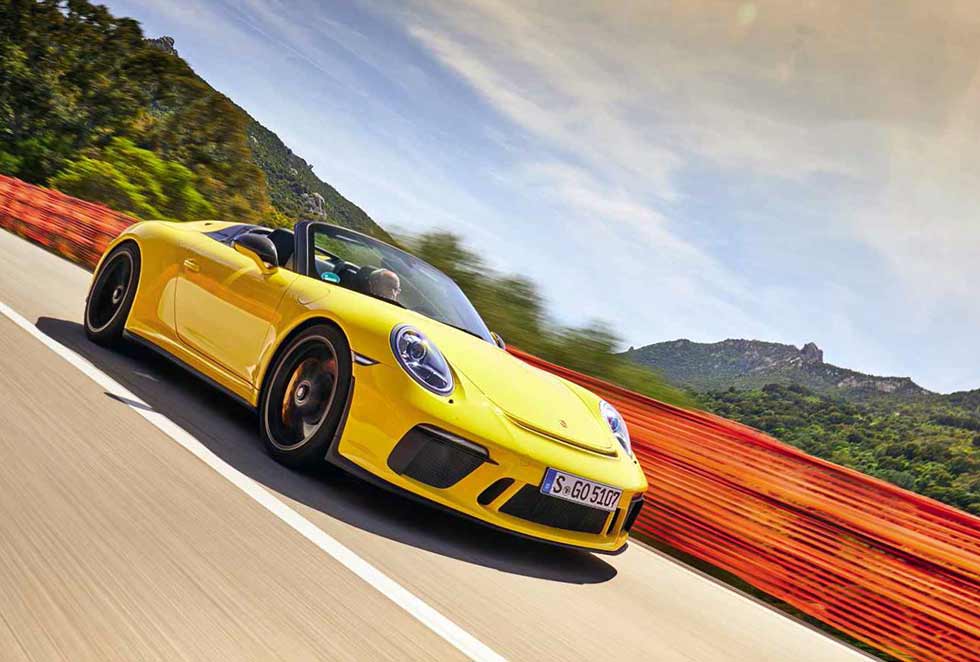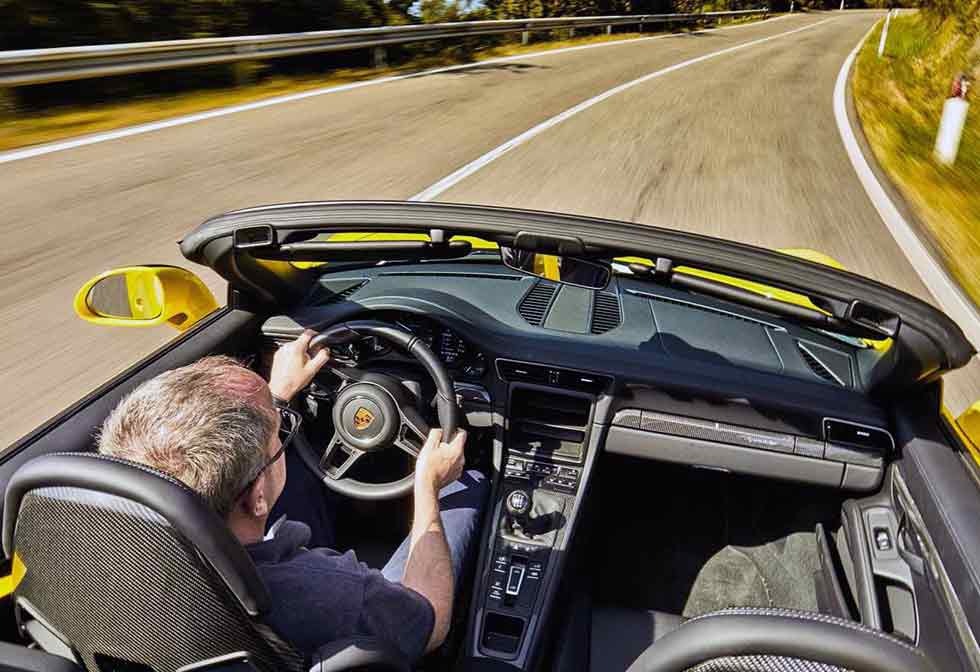
Built to celebrate Porsche’s 70th anniversary, and packing a GT3 engine and chassis, the new Speedster sees the 991-generation 911 go out on a high. Words by Stuart Gallagher. Photography by Matt Howell.
There is a great deal to take in when it comes to Porsche’s new 911 Speedster 991.2, even before you familiarise yourself with the procedure to open its roof. Not least is that this new Porsche 911 is not based on the all-new 992 generation of 911, rather it is the last – the very last – 991-generation model that Porsche will build. You also need to consider that, unlike four of the last five 911 Speedsters, this is only the second such open 911 to follow the principles of the company’s go-faster Motorsport department (the 964 RS-inspired Speedster launched in 1992 was the first). And then there’s its chassis and powertrain, the former one of the sweetest on any 911, the latter possibly one of the greatest, but more on these a little later.

This Speedster’s tale began in 2013, when Andreas Preuninger tasked his team to design a Speedster in the spirit of the GT road cars that his department is famed for. A key criteria was that it had to have the lowest possible ‘fly-line’ (the line that runs from the top of the windscreen header rail to the rear of the car) and, perhaps a little controversially for Speedster aficionados, no pronounced humps behind the driver. The presented designs were met with an unprecedented thumbs up and the project given an instant go-ahead… although it couldn’t be revealed to the public for another five years, Porsche’s board wanting the car to mark the company’s 70th anniversary in 2018.
‘MAKE NO MISTAKE; IT MEETS THE GT DEPARTMENT’S STRICT REQUIREMENTS’

‘THE SPEEDSTER FLOWS WITH THE ROAD RATHER THAN BEATING IT INTO SUBMISSION’
Porsche being Porsche, it naturally sat around twiddling its thumbs waiting for the 2018 Festival of Speed and the grand unveiling of its new open-top 911. Or not. In fact, during those 60 months a period of extensive development took place, to hone what is a very complex car – both in its construction and its engineering.
The original concept from 2013 took the front end of a then current 991-generation GT3 and melded (or rather welded) it to the back of a 911 Carrera 4S Cabriolet shell, the soft-top Carrera 4 shell being stiffer than the coupe’s would be with the roof chopped off. Underneath and inside it was the same too, the first-gen 991 donating everything, from suspension components to engine and gearbox and interior.

Today it’s pure last-of-the-line Gen 2 991 – to look at, underneath and inside. A number of concept parts have fallen off along the way, such as the 21-inch wheels and the minimalist tonneau cover in lieu of a full fabric roof (some at Porsche didn’t want the Speedster to be burdened with such luxury). The bullet-like racing mirrors didn’t survive the production sign-off, either, nor the centre fuel filler flap. Thanks, rule makers. But the 50mm drop in windscreen height remained.
Along with the other bodywork changes, the result is one of the sleekest 911s of the 991 generation. It’s proportionally well stacked, low and streamlined enough to pull off the Speedster iconography, with plenty of aggression in the aero detailing around the front and rear PUs – although it does have a rather large backside, exaggerated by the bespoke engine/roof cover that is also home to a pair of pop-out rollover hoops. To keep the lines clean there is no fixed rear wing; instead an active rear spoiler deploys at speed, and works in conjunction with a rear diffuser.
‘VENTURE BEYOND 6000RPM AND THE SPEEDSTER BECOMES ALL-CONSUMING’
If the former sounds very 911 R and GT3 Touring, that’s no coincidence. ‘The philosophy with this car is the same as we had for the 911 R and, to some extent, the GT3 Touring,’ explains Andreas Preuninger between mouthfuls of pizza. ‘This isn’t a GT car we have designed for the track, it doesn’t have the downforce for that. It’s a 911 GT car that we have designed for the road. It’s a little less direct, more forgiving, but this makes the Speedster a better – quicker – road car.’
The bulk of the dynamic changes are down to the 20 per cent loss in rigidity compared with the Gen 2 991 GT3, although the spring rates remain the same as on that car. What has made the difference is the advancement in damper technology when it comes to Porsche’s active suspension system. ‘This is where we see the big advantages,’ explains Preuninger (post pizza). ‘The system hardware is unchanged but the tuning capabilities are always improving. The damping on this car is the very best available on any current GT car. The newest car always benefits from such developments.
‘It’s like EPAS. It gets better every time. It gives us more options, allows us to set the car up with more precision than we ever had in the past. Our new car is always the best. We don’t hold anything back for the next GT3; that car will have even better damping and steering.’
It’s the suppleness of the Speedster that strikes you first. There’s still the taut, locked-down-feel of any 911 GT model; that no-nonsense approach of a GT3’s chassis that filters out the unnecessary while feeding back the necessary at any speed and which marks it out as one of the very, very best in the business. In the Speedster, compared to a GT3, what stands out is its ability to finesse those hard points and smooth out the inherent harshness that comes with a car focused on track work.
As with the 911 R, the Speedster flows with the road rather than beating it into submission. Like an Alpine A110, it’s not soft in a roly-poly Rolls-Royce Corniche type of way, rather its damping and body control precisely manage every input with a level of control and precision that only McLaren’s Proactive Chassis Control hydraulic damping system can better.
As a consequence of such levels of control, your confidence in the Speedster grows with every turn, twist and broken section of road surface you come across. What we have come to accept in a GT3 as a gnarly set-up perfected to extract a lap time feels like a compromise on the road after the Speedster. Like with the 911 R, you find yourself developing a far greater connection with the surface than you would in a GT3, the absence of the aggressive nature of the latter allowing you to immerse yourself deeper in the experience. In a world where every new car must be faster against the clock, this is a hugely refreshing experience.
Not that the Speedster is slow. How could it be with one of the finest naturally aspirated engines of the modern era: the GT3’s 4-litre flat-six? A great engine that’s been tuned, fettled and perfected even further for this latest application. There’s a new rigid valvetrain system and central oil supply. The dry-sump lubrication has been further enhanced and there are plasma coatings for the bore liners. The inlet manifold is lighter, the pistons remain forged, the con-rods titanium. New injectors work at pressures increased by 50bar to 250, and the individual throttle valves create a larger swirl area, allowing more air into the engine at a higher speed. There’s also a lighter exhaust system, by some 10kg, which Porsche is rather proud of because it also includes the necessary particulate filters that allow the engine to meet the latest emission targets.
It’s equally proud that the aforementioned emission control devices haven’t robbed the motor of any power; in fact it’s gained an additional 10bhp over the GT3, raising its peak to 503bhp. It didn’t need more power, of course, because this engine, the very same engine that you will find beneath the wing and engine cover of a Carrera Cup race car (bar a different exhaust system), has proven to be one of the most intoxicating for a generation. With the fitment of a dual-mass flywheel (in place of the GT3’s single-mass unit), you lose the distinctive sound of a washing machine on a fast cycle trying to remove the gearbox oil from a set of ratios, but this aside it remains an engine to behold.
Detecting the improved throttle response over a GT3 that Porsche claims is a task for a back-to-back comparison, not that the GT3’s engine has ever been labelled tardy in this area. Anyway, you’re far too focused on savouring the moment a thousand or so components work in unison to produce a savage level of performance that builds with such linearity it stills knocks you back, regardless of how much previous exposure you’ve had to it.
That a six-speed manual gearbox controls it all, adding to the theatre you’re conducting, is a rather delicious accompaniment to this finest slice of Swabian delicacy. Although, the unfamiliar surroundings of an open-top 911 with a GT3 motor can cause a mild faux pas for those first miles after the fluids are warmed through and the road starts twisting this way and that. The issue is reminding yourself that this is no modern day, torque fat, power light, characterless turbo engine that’s all done by 6000rpm and on its knees wheezing less than 1000rpm later. No, this is a motor designed to rev. It demands them.
There remains the fullest of kicks at 3k, an initial surge that switches you on, priming your clutch foot. But it’s all too easily followed, rather embarrassingly, by a premature upshift at around 6k because you think it’s all done. And no one wants a premature finish when there’s plenty more on offer. It happens once and I hope photographer Matt Howell hasn’t noticed (of course he has, photographers notice everything). On the second occasion I feel I should apologise (I don’t, naturally). There isn’t a third time because when you venture beyond six-thou the Speedster becomes all- consuming: an experience combining the wild nature of a 911 R with a soundtrack amplified by the open nature of the car, every sound reverberating off the surrounding countryside, infiltrating your senses.
With every passing 500 metres you climb deeper into the Speedster’s DNA. Your wrists roll, the front Michelin Pilot Cup 2s grip, the weight transfer across the axles produces the gentlest degree of roll for you to lean against as you squeeze in the throttle, listen for the engine note to gain an octave or two, feel the grip build further as the outer edges of those Hubba Bubba-sticky Michelins take the fight to the tarmac. And then, as the tarmac fights back, you’re exiting the corner, your eyes focused on the next challenge, your backside still feeling for the last remains of the previous one as the Speedster completes its four-square dance across the road, mechanical diff hooked up, rear-wheel steering nibbling away where needed, the front wheels already pointing straight ahead before the corner exit has become the next straight, the rear wheels driving you through, out and on your way. From turn-in to exit, the Speedster feels like it’s entered slow-mo mode, the actions and reactions so intuitive that you can slow it all down in your brain, revel in the sensations: the sound, the rush, the thrill. Then bang! Out of the corner, throttle pinned, 5-6-7-8500rpm, a flat-six straining its vocal chords, your right hand working as quick as it can to execute the next gearchange. The pace is relentless when you let the Speedster have its fill. Combined with its more road- biased chassis, it feels unstoppable.
It also feels incredibly special. The unique looks play a role, so too the fabulous engine and gearbox, the masterful chassis, the precision of the steering, the strength of the standard-fit-carbon-ceramic brakes. There’s theatre to how the roof retracts and how the rear deck is operated, which aside from the electric release from the header rail is an all-manual affair. Meanwhile the interior blends modern performance assets, such as snug carbon bucket seats, with retro detailing. And the lightweight door-cards are a given. All conspire to create a very desireable package.
There’s more, because in a bid to keep the weight down (1465kg since you’re asking – 52kg more than a GT3), Porsche fitted a carbonfibre bonnet (6kg saving) and front wings (2kg apiece), and also used the lightweight material for the rear deck, which tips the scales at only 10kg. Make no mistake, this is a Speedster that meets the GT department’s strict requirements, rather one built by them to the marketing team’s desires.
Porsche’s Speedster story began back in 1954, when the company’s US importer, Max Hoffman, asked Ferdinand Porsche for a cheaper 356 that he could sell to younger, less affluent customers. Herr Porsche wasn’t convinced there would be a market for such a model, but tasked his engineers to work on a suggestion, the result being the lighter, cheaper 356 Speedster that Porsche thought Hoffman might be able to sell five examples of in a year. Hoffman reckoned he could sell five a week. And he did, and then some, with North America taking to the Speedster with such enthusiasm that it became a mainstream model, establishing itself as Porsche’s first performance car icon.
With only 1948 examples of the latest Speedster to be built, it would be easy to dismiss it as a marketing exercise to mark a milestone and cash in on the occasion (and at £211,599 each, Porsche certainly will). But that would also be selling a remarkable car shorter than a trader dumping Tesla stock with every Elon Musk tweet. Not only is this latest 911 Speedster a great 911, it’s one of the best modern-era 911s. Another legend in the making.
Below: rear deck needs to be raised manually to access the fabric roof (also manually operated), but because the deck is carbonfibre, it’s no effort to lift.
Top right: interior gets carbon-backed bucket seats as standard, plus lightweight door cards, a Sport steering wheel and a shortened gearlever. Opposite page: front bumper is from the GT3, while the active rear spoiler is from the GT3 Touring and sits flush with the bodywork until required.
2019 Porsche 911 Speedster 991.2
Engine Flat-six, 3996cc
Max Power 503bhp @ 8400rpm
Max Torque 347lb ft @ 6250rpm
Weight 1465kg (349bhp/ton)
0-62mph 4.0sec
Top speed 192mph
Basic price £211,599
Drive-My rating ★★★★★






